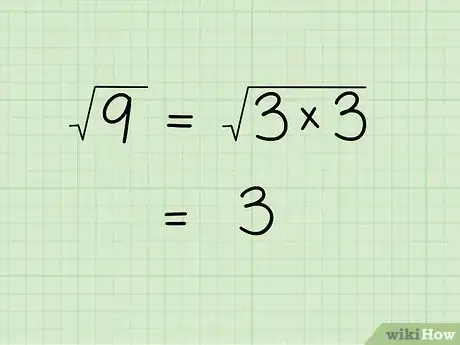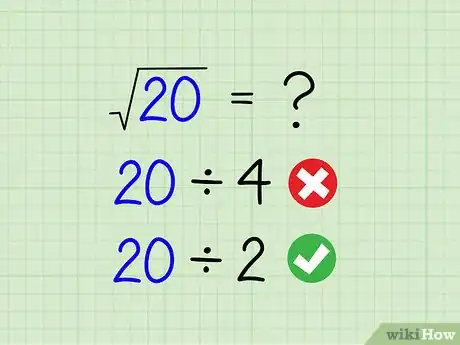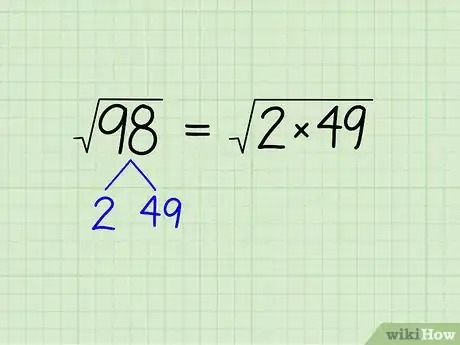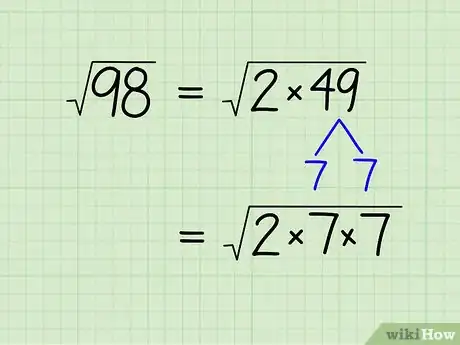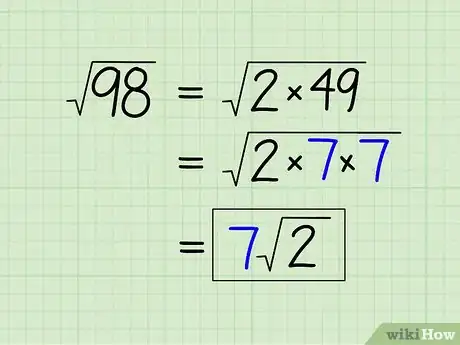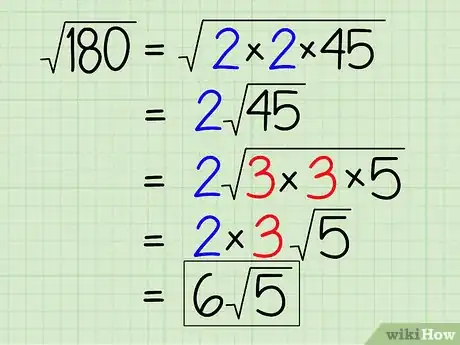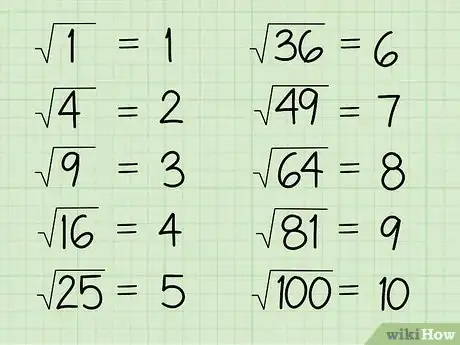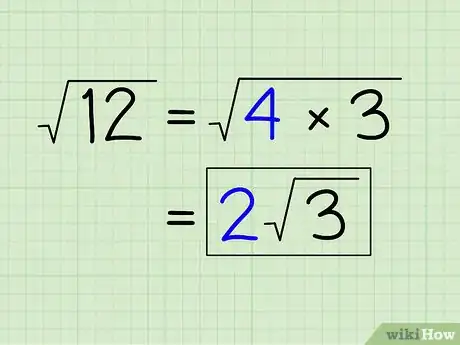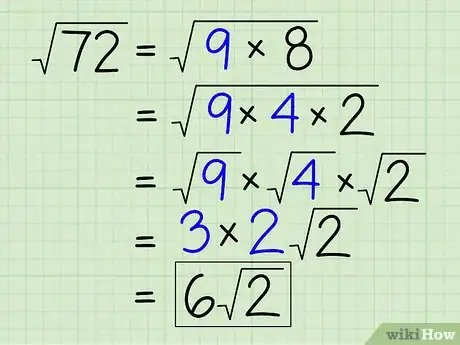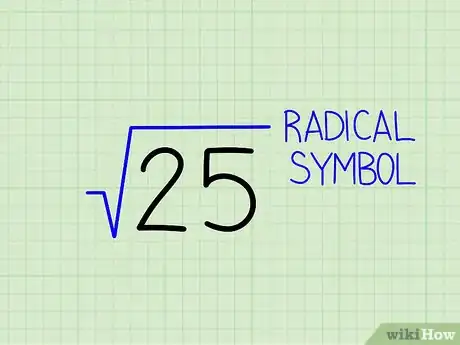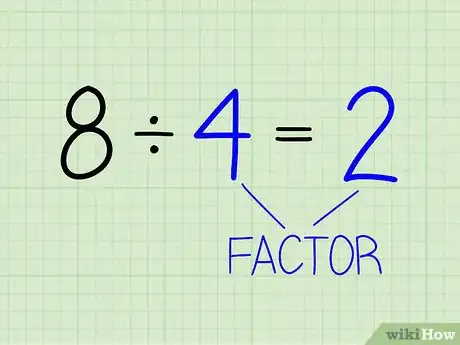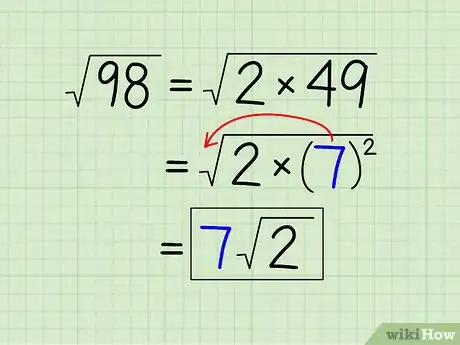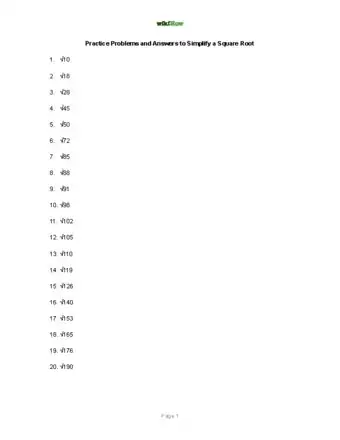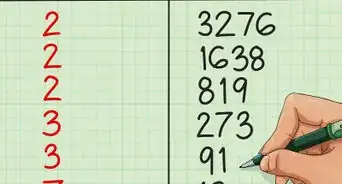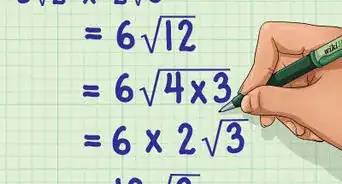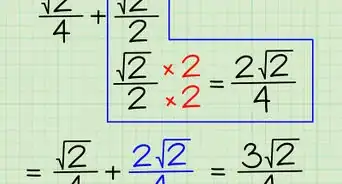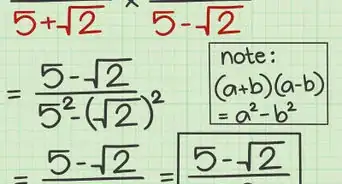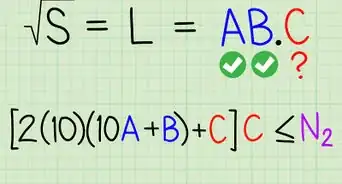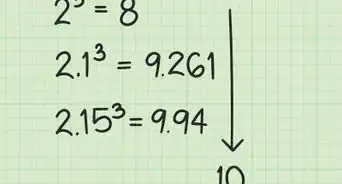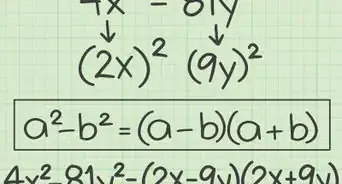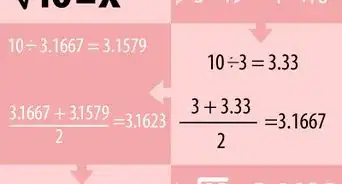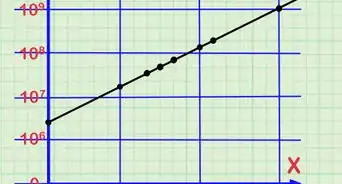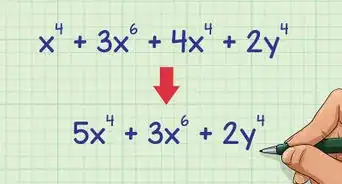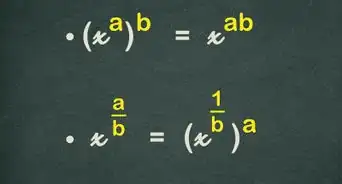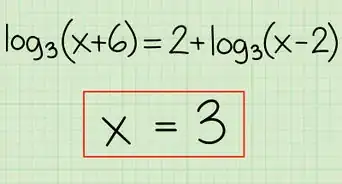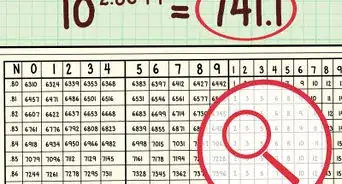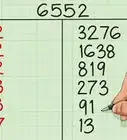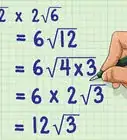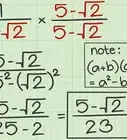This article was co-authored by David Jia. David Jia is an Academic Tutor and the Founder of LA Math Tutoring, a private tutoring company based in Los Angeles, California. With over 10 years of teaching experience, David works with students of all ages and grades in various subjects, as well as college admissions counseling and test preparation for the SAT, ACT, ISEE, and more. After attaining a perfect 800 math score and a 690 English score on the SAT, David was awarded the Dickinson Scholarship from the University of Miami, where he graduated with a Bachelor’s degree in Business Administration. Additionally, David has worked as an instructor for online videos for textbook companies such as Larson Texts, Big Ideas Learning, and Big Ideas Math.
This article has been viewed 1,383,757 times.
Simplifying a square root isn't as hard as it looks. To simplify a square root, you just have to factor the number and pull the roots of any perfect squares you find out of the radical sign. Once you've memorized a few common perfect squares and know how to factor a number, you'll be well on your way to simplifying the square root.
Steps
Simplifying a Square Root by Factoring
-
1Understand factoring. The goal of simplifying a square root is to rewrite it in a form that is easy to understand and to use in math problems. Factoring breaks down a large number into two or more smaller factors, for instance turning 9 into 3 x 3. Once we find these factors, we can rewrite the square root in simpler form, sometimes even turning it into a normal integer. For example, √9 = √(3x3) = 3. Follow the steps below to learn this process for more complicated square roots.[1]
-
2Divide by the smallest prime number possible. If the number under the square root is even, divide it by 2. If your number is odd, try dividing it by 3 instead. If neither of these gives you a whole number, move down this list, testing the other primes until you get a whole number result. You only need to test the prime numbers, since all other numbers have prime numbers as their factors. For example, you don't need to test 4, because any number divisible by 4 is also divisible by 2, which you already tried.[2]
- 2
- 3
- 5
- 7
- 11
- 13
- 17
Advertisement -
3Rewrite the square root as a multiplication problem. Keep everything underneath the square root sign, and don't forget to include both factors. For example, if you're trying to simplify √98, follow the step above to discover that 98 ÷ 2 = 49, so 98 = 2 x 49. Rewrite the "98" in the original square root using this information: √98 = √(2 x 49).[3]
-
4Repeat with one of the remaining numbers. Before we can simplify the square root, we keep factoring it until we've broken it down into two identical parts. This makes sense if you think about what a square root means: the term √(2 x 2) means "the number you can multiply with itself to equal 2 x 2." Obviously, this number is 2! With this goal in mind, let's repeat the steps above for our example problem, √(2 x 49):
- 2 is already factored as low as it will go. (In other words, it's one of those prime numbers on the list above.) We'll ignore this for now and try to divide 49 instead.
- 49 can't be evenly divided by 2, or by 3, or by 5. You can test this yourself using a calculator or long division. Because these don't give us nice, whole number results, we'll ignore them and keep trying.
- 49 can be evenly divided by seven. 49 ÷ 7 = 7, so 49 = 7 x 7.
- Rewrite the problem: √(2 x 49) = √(2 x 7 x 7).
-
5Finish simplifying by "pulling out" an integer. Once you've broken the problem down into two identical factors, you can turn that into a regular integer outside the square root. Leave all other factors inside the square root. For example, √(2 x 7 x 7) = √(2)√(7 x 7) = √(2) x 7 = 7√(2).[4]
- Even if it's possible to keep factoring, you don't need to once you've found two identical factors. For example, √(16) = √(4 x 4) = 4. If we kept on factoring, we'd end up with the same answer but have to do more work: √(16) = √(4 x 4) = √(2 x 2 x 2 x 2) = √(2 x 2)√(2 x 2) = 2 x 2 = 4.
-
6Multiply integers together if there are more than one. With some large square roots, you can simplify more than once. If this happens, multiply the integers together to get your final problem. Here's an example:
- √180 = √(2 x 90)
- √180 = √(2 x 2 x 45)
- √180 = 2√45, but this can still be simplified further.
- √180 = 2√(3 x 15)
- √180 = 2√(3 x 3 x 5)
- √180 = (2)(3√5)
- √180 = 6√5
-
7Write "cannot be simplified" if there are no two identical factors. Some square roots are already in simplest form. If you keep factoring until every term under the square root is a prime number (listed in one of the steps above), and no two are the same, then there's nothing you can do. You might have been given a trick question! For example, let's try to simplify √70:[5]
- 70 = 35 x 2, so √70 = √(35 x 2)
- 35 = 7 x 5, so √(35 x 2) = √(7 x 5 x 2)
- All three of these numbers are prime, so they cannot be factored further. They're all different, so there's no way to "pull out" an integer. √70 cannot be simplified.
Knowing the Perfect Squares
-
1Memorize a few perfect squares. Squaring a number, or multiplying it by itself, creates a perfect square. For example, 25 is a perfect square because 5 x 5, or 52, equals 25. Memorizing at least the first ten perfect squares can help you recognize and quickly simplify perfect square roots. Here are the first ten perfect squares:
- 12 = 1
- 22 = 4
- 32 = 9
- 42 = 16
- 52 = 25
- 62 = 36
- 72 = 49
- 82 = 64
- 92 = 81
- 102 = 100
-
2Find the square root of a perfect square. If you recognize a perfect square under a square root symbol, you can immediately turn it into its square root and get rid of the radical sign (√). For example, if you see the number 25 under the square root sign, you know that the answer is 5 because 25 is a perfect square. Here's the same list as above, going from the square root to the answer:[6]
- √1 = 1
- √4 = 2
- √9 = 3
- √16 = 4
- √25 = 5
- √36 = 6
- √49 = 7
- √64 = 8
- √81 = 9
- √100 = 10
-
3Factor numbers into perfect squares. Use the perfect squares to your advantage when following the factor method of simplifying square roots. If you notice a way to factor out a perfect square, it can save you time and effort. Here are some tips:[7]
- √50 = √(25 x 2) = 5√2. If the last two digits of a number end in 25, 50, or 75, you can always factor out 25.
- √1700 = √(100 x 17) = 10√17. If the last two digits end in 00, you can always factor out 100.
- √72 = √(9 x 8) = 3√8. Recognizing multiples of nine is often helpful. There's a trick to it: if all digits in a number add up to nine, then nine is always a factor.
- √12 = √(4 x 3) = 2√3. There's no special trick here, but it's usually easy to check whether a small number is divisible by 4. Keep this in mind when looking for factors.
-
4Factor a number with more than one perfect square. If the number's factors contain more than one perfect square, move them all outside the radical symbol. If you found multiple perfect squares during your simplification process, move all of their square roots to the outside of the √ symbol and multiply them together. For example, let's simplify √72:
- √72 = √(9 x 8)
- √72 = √(9 x 4 x 2)
- √72 = √(9) x √(4) x √(2)
- √72 = 3 x 2 x √2
- √72 = 6√2
Knowing the Terminology
-
1Know that the radical symbol (√) is the square root symbol. For example, in the problem, √25, "√" is the radical symbol.[8]
-
2Know that the radicand is the number inside the radical symbol. You will need to find the square root of this number. For example, in the problem √25, "25" is the radicand.[9]
-
3Know that the coefficient is the number outside the radical symbol. This is the number that the square root is being multiplied by; this sits to the left of the √ symbol. For example, in the problem, 7√2, "7" is the coefficient.
-
4Know that a factor is a number that can be evenly divided out of another number. For example, 2 is a factor of 8 because 8 ÷ 4 = 2, but 3 is not a factor of 8 because 8÷3 doesn’t result in a whole number. As another example, 5 is a factor of 25 because 5 x 5 = 25.
-
5Understand the meaning of simplifying a square root. Simplifying a square root just means factoring out any perfect squares from the radicand, moving them to the left of the radical symbol, and leaving the other factor inside the radical symbol. If the number is a perfect square, then the radical sign will disappear once you write down its root. For example, √98 can be simplified to 7√2.
Practice Problems and Answers
Community Q&A
-
QuestionWhat is the simplest radical form?
 wikiHow Staff EditorThis answer was written by one of our trained team of researchers who validated it for accuracy and comprehensiveness.
wikiHow Staff EditorThis answer was written by one of our trained team of researchers who validated it for accuracy and comprehensiveness.
Staff Answer wikiHow Staff EditorStaff AnswerIf something is written in its simplest radical form, that means that you have already found all possible roots and eliminated any radicals from the denominator of a fraction. A square root can’t be simplified any further if there are no 2 identical factors remaining and every term under the radical symbol is a prime number.
wikiHow Staff EditorStaff AnswerIf something is written in its simplest radical form, that means that you have already found all possible roots and eliminated any radicals from the denominator of a fraction. A square root can’t be simplified any further if there are no 2 identical factors remaining and every term under the radical symbol is a prime number. -
QuestionHow do you simplify radical fractions?
 wikiHow Staff EditorThis answer was written by one of our trained team of researchers who validated it for accuracy and comprehensiveness.
wikiHow Staff EditorThis answer was written by one of our trained team of researchers who validated it for accuracy and comprehensiveness.
Staff Answer wikiHow Staff EditorStaff AnswerStart by multiplying the numerator and denominator by a radical that will eliminate the radical in the denominator. For example, if your fraction is 2/√7, multiply by √7/√7 to get 2√7/√49. This will simplify to 2√7/7. If possible, simplify the fraction by dividing out any common factors in the numerator and denominator.
wikiHow Staff EditorStaff AnswerStart by multiplying the numerator and denominator by a radical that will eliminate the radical in the denominator. For example, if your fraction is 2/√7, multiply by √7/√7 to get 2√7/√49. This will simplify to 2√7/7. If possible, simplify the fraction by dividing out any common factors in the numerator and denominator. -
QuestionHow do you simplify square roots with variables?
 wikiHow Staff EditorThis answer was written by one of our trained team of researchers who validated it for accuracy and comprehensiveness.
wikiHow Staff EditorThis answer was written by one of our trained team of researchers who validated it for accuracy and comprehensiveness.
Staff Answer wikiHow Staff EditorStaff AnswerUse the same procedure you would for simplifying square roots with numerical radicands. Bring any identical pairs of factors out of the radical to become the coefficient. For example, if you need to simplify √25a^3, change it to √5×5×a×a×a. Factor out 5 and a^2 to get 5a^2√a.
wikiHow Staff EditorStaff AnswerUse the same procedure you would for simplifying square roots with numerical radicands. Bring any identical pairs of factors out of the radical to become the coefficient. For example, if you need to simplify √25a^3, change it to √5×5×a×a×a. Factor out 5 and a^2 to get 5a^2√a.
Warnings
- Calculators can be useful for large numbers, but the more you practice working this out on your own, the easier this will get.⧼thumbs_response⧽
- Simplifying is not the same as evaluating. At no point in this process should you get a number with a decimal point in it!⧼thumbs_response⧽
References
- ↑ https://www.khanacademy.org/math/algebra/rational-exponents-and-radicals/alg1-simplify-square-roots/v/simplifying-square-roots-1
- ↑ https://www.khanacademy.org/math/algebra/rational-exponents-and-radicals/alg1-simplify-square-roots/v/simplifying-square-roots-1
- ↑ https://www.khanacademy.org/math/algebra/rational-exponents-and-radicals/alg1-simplify-square-roots/v/simplifying-square-roots-1
- ↑ https://www.khanacademy.org/math/algebra/rational-exponents-and-radicals/alg1-simplify-square-roots/v/simplifying-square-roots-1
- ↑ https://www.khanacademy.org/math/algebra/rational-exponents-and-radicals/alg1-simplify-square-roots/v/simplifying-square-roots-1
- ↑ https://www.prodigygame.com/in-en/blog/multiplying-square-roots/
- ↑ https://mathbitsnotebook.com/Algebra1/Radicals/RADSimplifyingRadicals.html
- ↑ http://www.mathwords.com/r/radical.htm
- ↑ http://www.mathwords.com/r/radicand.htm
About This Article
To simplify a square root, start by dividing the square root by the smallest prime number possible. For example, if you're trying to find the square root of 98, the smallest prime number possible is 2. If you divide 98 by 2, you get 49. Then, rewrite the square root as a multiplication problem under the square root sign. In this case, you'd rewrite the square root as 2 × 49 under the square root sign. From there, keep factoring the numbers until you have 2 identical factors. In this example, 49 divided by 7 is 7. Rewrite the square root as 2 × 7 × 7. Finally, once you have two identical numbers, move them outside of the square root to make them a regular integer. So the simplified square root of 98 is 7 × the square root of 2. However, if you factor the numbers inside the square root as much as you can without getting two identical numbers, then your square root can't be simplified! To learn other ways you can simplify a square root, keep reading!
